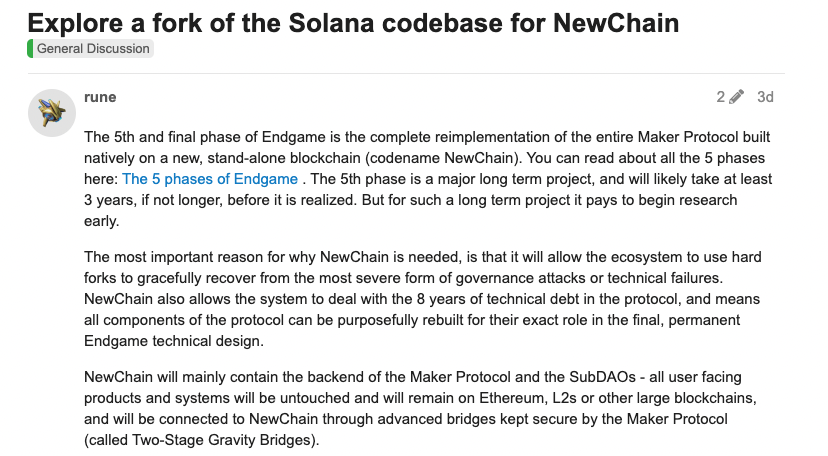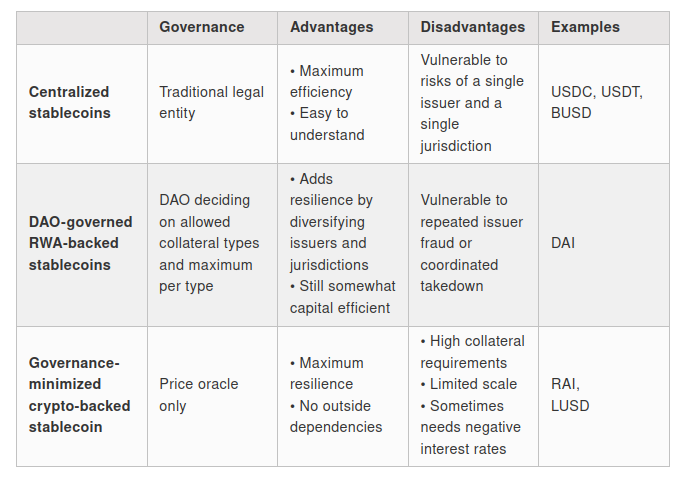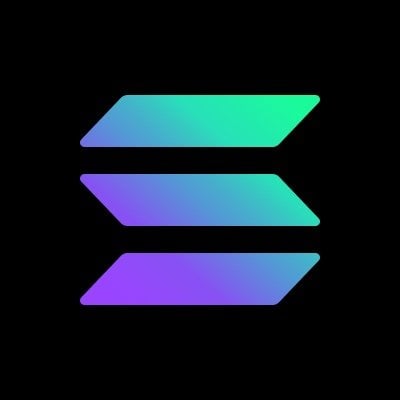MakerDAO chooses Solana as the application chain? It's too early to draw conclusions; it will take at least 3 years to realize
Author: Jiang Haibo, PANews
After shifting its focus to RWA (real-world assets), Maker DAO has become one of the most profitable DeFi projects. However, co-founder Rune Christensen's bold improvements to Maker often spark questions and discussions.
On September 1, Rune published an article titled "Explore a fork of the Solana codebase for NewChain" in the MakerDAO forum, exploring the possibility of creating a new application chain, NewChain, based on the Solana codebase. This directly led to Ethereum co-founder Vitalik selling his long-held MKR.

Rune's Views and Impact on NewChain
Regarding the creation of a new chain, Rune believes the main purpose is to enable recovery through hard forks in the event of governance attacks or technical failures. Additionally, according to the Endgame timeline, it is expected that a new stablecoin (NewStable) and a new governance token (NewGovToken) will be launched in the first phase, which is early 2024. If this economic model operates on its own chain, it will also bring greater benefits through token economics, such as reducing MEV and minimizing value loss in transaction costs (by using its own governance token or stablecoin to pay gas fees).
As for why Rune favors Solana, it mainly lies in the high quality of Solana's code, the resilience of its ecosystem after the collapse of FTX, and the existence of application chains like Pyth built on Solana.
Besides Solana, Rune also mentioned Cosmos in his article and subsequent replies, considering it the only alternative to Solana, with a large number of high-quality developers, but with lower efficiency and higher maintenance costs compared to Solana. For new public chains like Aptos and Sui, Rune directly stated that he believes they are not suitable after a brief study.
Regarding the impact of this matter, PANews believes it is not that significant for several reasons.
- Rune's article was published under "General Discussion" and is currently only in the discussion phase, not a formal survey or execution vote.
- Regarding the implementation timeline, according to the Endgame timeline, NewChain is in the fifth phase, which is the final phase. It is expected to take at least 3 years, or longer, to realize, and there is still a long way to go with many uncertainties.
- Even if the Maker protocol is rebuilt using NewChain, all user-facing products and systems will remain unchanged and will still be on Ethereum or other blockchains. The only difference is that the backend of the Maker protocol and SubDAO will be built on NewChain to improve security and the value capture capability of tokens.
In the discussion thread, different proposals were also raised, such as the EVM-based Rollup proposed by Hasu, the strategic head of Flashbots, and others suggested the Substrate framework of the Polkadot ecosystem, Eclipse's Rollup framework, etc.
Vitalik's Counterattack and Optimism for Rai
As one of the most representative projects in the Ethereum ecosystem, Maker has various Raas (Rollup as a Service) solutions in the Ethereum ecosystem, such as Base and Worldcoin, which use the OP Stack, even as an application chain. However, Rune's ambitions are not limited to this; he hopes to capture all possible value in the ecosystem and use NewChain as a bridge to expand to other Layer 1s.
This move may be seen as a "betrayal" of the Ethereum ecosystem and has directly drawn dissatisfaction from figures including Ethereum co-founder Vitalik, who sold his last 500 MKR through Cow Protocol. Vitalik's first purchase of MKR occurred in January 2018, when he exchanged 21.34 WETH for 14.28 MKR, and his most recent transfer was in April 2021 when he donated 100 MKR to India's Covid relief fund.
In Reflexer’s Discord, when someone quoted Rune's tweet about NewChain, Vitalik stated that Maker's DAI was once the representative of the third type of stablecoin (collateralized by crypto assets) in the image below, but it seems to be heading in a completely different direction now. The Rai community can engage in more proactive governance to support various non-major staked ETH (excluding Lido's wst ETH) as collateral.

Since Reflexer’s native token is designed as a governance-minimized token, under this mechanism, the project cannot support collateral other than ETH through simple governance. Projects like Liquity face this issue as well and must improve to capture the LSDFi market.
Vitalik has long been optimistic about Reflexer; he has expressed his positive views on Reflexer multiple times. During the USDC de-pegging in March this year, he also collateralized ETH to mint RAI and then used RAI to purchase USDC.
Such projects may be more important for their strategic significance to Ethereum, with innovations in both the stablecoin mechanism and governance token functionality. From the perspective of collateral, it only uses ETH (which may expand to LSD in the future) as collateral; the stablecoin RAI is not pegged to the dollar and has lower volatility than ETH, making it a new type of stablecoin; the design of minimized governance also aligns better with the "Code is Law" principle. If it can indeed enhance Reflexer’s governance capabilities, then an increase in FLX's price would make sense.
However, for ordinary users, the advantages of RAI become disadvantages; its price is neither as stable as centralized stablecoins nor as volatile as ETH; it has fewer use cases as a stablecoin; and FLX also lacks value capture functionality.
As of the afternoon of September 4, the price of Reflexer’s governance token FLX rose by 75% in the past 24 hours due to Vitalik's endorsement, reaching $14, but it is still down 99% compared to its issuance price of $1400.
Seven Functional Requirements for NewChain
This is not Rune's first time expressing views on NewChain; back in May 2022, he outlined the plans and key features of NewChain, which also mentioned the need for a hard fork as a governance mechanism to recover from disasters.
On January 31 of this year, Rune also published a Maker Improvement Proposal, which was approved on March 27, clearly listing seven functional requirements for NewChain.
- NewChain must support native staking functionality compatible with the "Sagittarius Engine," and the rights of nodes must be managed by the Maker governance mechanism.
- NewChain should support the collection of "State Rent," charging fees for data stored on the blockchain to encourage effective data management.
- Gas fees and state rent should be paid using NewStable, while rights should be completed using NewGovToken.
- NewChain must have native MEV capture capabilities.
- NewChain must have a chain shutdown function triggered by voting executed by NewGovToken, which must then be restarted through a hard fork. As the functions of Maker and SubDAO become increasingly complex, hard forks provide an additional layer of security.
- The protocol should have built-in ZK rollups.
- The new token economics and core governance processes should be natively built into the new chain protocol.
This also indicates that Rune's ambitions are not limited to the Ethereum ecosystem; even when using Ethereum's Layer 2 solutions, there will inevitably be fees to pay for submitting bundled transactions to Layer 1. These fees can only be paid using ETH, and the resulting value cannot be captured by the new governance token or new stablecoin.
Conclusion
Maker originated from the Ethereum ecosystem, and due to the increasing complexity of its functions, it needs to become an independent application chain to recover through hard forks in extreme situations. In terms of solution selection, Rune hopes to capture all value, including gas fees, and expand to other Layer 1s, with Solana becoming a more likely choice, which has also drawn counterattacks from figures like Vitalik.
However, it is important to note that the current proposal is only in the discussion phase, and NewChain is in the final phase of Endgame, expected to take at least 3 years to realize. Before that, Maker has a lot of work to do and may choose other solutions due to technological iterations.













